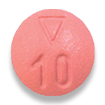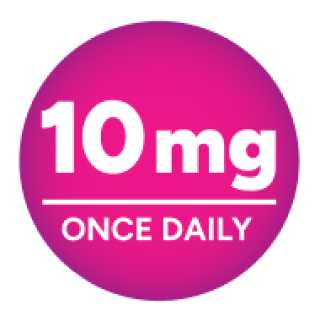REFERENCES: 1. Eriksson BI, Borris LC, Friedman RJ, et al; RECORD1 Study Group. Rivaroxaban versus enoxaparin for thromboprophylaxis after hip arthroplasty. N Engl J Med. 2008;358(26):2765-2775. 2. Kakkar AK, Brenner B, Dahl OE, et al; RECORD2 Investigators. Extended duration rivaroxaban versus short-term enoxaparin for the prevention of venous thromboembolism after total hip arthroplasty: a double-blind, randomised controlled trial. Lancet. 2008;372(9632):31-39.
3. Lassen MR, Ageno W, Borris LC, et al; RECORD3 Investigators. Rivaroxaban versus enoxaparin for thromboprophylaxis after total knee arthroplasty. N Engl J Med. 2008;358(26):2776-2786.
4. Turpie AGG, Haas S, Kreutz R, et al. A non-interventional comparison of rivaroxaban with standard of care for thromboprophylaxis after major orthopaedic surgery in 17,701 patients with propensity score adjustment. Thromb Haemost. 2014;111(1):94-102.
In the RECORD trials
Significantly lower rates of total* and major† VTE following hip replacement surgery1,2
Total VTE
1.1% (18/1595) with XARELTO®
vs
3.7% (58/1558) with enoxaparin
ARR=2.6%‡ (95% CI: 1.5-3.7) P<0.001
Major VTE
0.2% (4/1686) with XARELTO®
vs
2.0% (33/1678) with enoxaparin
ARR=1.7%‡ (95% CI: 1.0-2.5) P<0.001
Symptomatic VTE (secondary analysis)
0.3% (6/2193) with XARELTO®
vs
0.5% (11/2206) with enoxaparin
Results for the components of total VTE (XARELTO® versus enoxaparin): proximal DVT (0.1% versus 2.0%); distal DVT (0.7% versus 1.4%); nonfatal PE (0.3% versus 0.1%); death from any cause (0.3% versus 0.3%)
*Primary endpoint: total VTE was a composite of proximal and/or distal DVT, nonfatal PE, and death from any cause.
†Major VTE was a composite of proximal DVT, nonfatal PE, and VTE-related death.
‡ARR = risk (placebo) - risk (experimental).
ARR = absolute risk reduction; DVT = deep vein thrombosis;
VTE = venous thromboembolism.
Total VTE
2.0% (17/864) with extended-duration XARELTO®
vs
9.3% (81/869) with short-term enoxaparin
ARR=7.3‡ (95% CI: 5.2-9.4) P<0.0001
Major VTE
0.6% (6/961) with extended-duration XARELTO®
vs
5.1% (49/962) with short-term enoxaparin
ARR=4.5‡ (95% CI: 3.0-6.0) P<0.0001
Symptomatic VTE (secondary analysis)
0.2% (3/1212) with extended-duration XARELTO®
vs
1.2% (15/1207) with short-term enoxaparin
Results for the components of total VTE (extended-duration XARELTO® versus short-term enoxaparin): proximal DVT (0.6% versus 5.1%); distal DVT (1.0% versus 3.1%); nonfatal PE (0.1% versus 0.5%); death from any cause (0.2% versus 0.7%)
Due to differences in the duration of XARELTO® and enoxaparin treatment, study results may not be used to assess comparative efficacy
*Primary endpoint: total VTE was a composite of proximal and/or distal DVT, nonfatal PE, and death from any cause.
†Major VTE was a composite of proximal DVT, nonfatal PE, and VTE-related death.
‡ARR = risk (placebo) - risk (experimental).
ARR = absolute risk reduction; DVT = deep vein thrombosis; VTE = venous thromboembolism.
Significantly lower rates of total* and major† VTE following knee replacement surgery3
Total VTE
9.6% (79/824) with XARELTO®
vs
18.9% (166/878) with enoxaparin
ARR=9.2‡ (95% CI: 5.9-12.4) P<0.001
Major VTE
1.0% (9/908) with XARELTO®
vs
2.6% (24/925) with enoxaparin
ARR=1.6‡ (95% CI: 0.4-2.8) P=0.01
Symptomatic VTE (secondary analysis)
0.7% (8/1201) with XARELTO®
vs
2.0% (24/1217) with enoxaparin
Results for the components of total VTE (XARELTO® versus enoxaparin): proximal DVT (1.1% versus 2.3%); distal DVT (8.5% versus 15.9%); nonfatal PE (0% versus 0.5%); death from any cause (0% versus 0.2%)
*Primary endpoint: total VTE was a composite of proximal and/or distal DVT, nonfatal PE, and death from any cause.
†Major VTE was a composite of proximal DVT, nonfatal PE, and VTE-related death.
‡ARR = risk (placebo) - risk (experimental).
ARR = absolute risk reduction; DVT = deep vein thrombosis; VTE = venous thromboembolism.
 Consistent efficacy outcomes in XAMOS trial1-4*
Consistent efficacy outcomes in XAMOS trial1-4*
Efficacy outcomes in clinical trials and real-world study
RECORD1 (hip)
1.1% (18/1595) with XARELTO®
vs
3.7% (58/1558) with enoxaparin
ARR=2.6‡ (95% CI: 1.5-3.7) P<0.001
RECORD2 (hip)
2.0% (17/864) with extended-duration XARELTO®
vs
9.3% (81/869) with short-term enoxaparin
ARR=7.3‡ (95% CI: 5.2-9.4) P<0.0001
RECORD3 (knee)
9.6% (79/824) with XARELTO®
vs
18.9% (166/878) with enoxaparin
ARR=9.2‡ (95% CI: 5.9-12.4) P<0.001
XAMOS (hip/knee)
1.1% (99/8778) with XARELTO®
vs
1.7% (148/8635) with SOC†
*Results are not intended for direct comparison with clinical trials because the real-world studies were observational trials with no comparator arm. Differences in study designs, patient populations, definitions of safety or efficacy outcomes, as well as data collection methods, make it difficult to make direct comparisons either with clinical trials or with each other.
†The standard-of-care included – but was not limited to – low-molecular-weight heparins, unfractionated heparins, fondaparinux, dabigatran etexilate, acetylsalicylic acid and vitamin K antagonists. The type, duration and dose of pharmacological agents were determined by the attending physician before a patient was enrolled into the study.
‡ARR = risk (placebo) - risk (experimental).
RWE = real-world evidence; SOC = standard-of-care.
In the RECORD trials
Proven safety profile after hip or knee replacement surgery1,2
Rates of bleeding in RECORD1
Major bleeding
0.3% (6/2209) with XARELTO®
vs0.1% (2/2224) with enoxaparin
Any bleeding
6.0% (133/2209) with XARELTO®
vs5.9% (131/2224) with enoxaparin
CRNMB
2.9% (65/2209) with XARELTO®
vs2.4% (54/2224) with enoxaparin
Hemorrhagic wound
complications
complications
1.5% (34/2209) with XARELTO®
vs1.7% (38/2224) with enoxaparin
CRNMB = clinically relevant nonmajor bleeding.
Rates of bleeding in RECORD2
Major bleeding
<0.1% (1/1228) with XARELTO®
vs<0.1% (1/1229) with enoxaparin
Any bleeding
6.6% (81/1228) with XARELTO®
vs5.5% (68/1229) with enoxaparin
CRNMB
3.3% (40/1228) with XARELTO®
vs2.7% (33/1229) with enoxaparin
Hemorrhagic wound
complications
complications
1.6% (20/1228) with XARELTO®
vs1.7% (21/1229) with enoxaparin
CRNMB = clinically relevant nonmajor bleeding.
Major bleeding rates vs enoxaparin after knee
replacement surgery3
Rates of bleeding in RECORD3
Major bleeding
0.6% (7/1220) with XARELTO®
vs0.5% (6/1239) with enoxaparin
Any bleeding
4.9% (60/1220) with XARELTO®
vs4.8% (60/1239) with enoxaparin
CRNMB
2.7% (33/1220) with XARELTO®
vs2.3% (28/1239) with enoxaparin
Hemorrhagic wound
complications
complications
2.0% (25/1220) with XARELTO®
vs1.9% (24/1239) with enoxaparin
CRNMB = clinically relevant nonmajor bleeding.

Consistent safety profile in XAMOS trial1-4*
Safety outcomes in clinical trials and real-world study
RECORD1 (hip)
0.3% (6/2209) with XARELTO®
vs0.1% (2/2224) with enoxaparin
RECORD2 (hip)
<0.1% (1/1228) with XARELTO®
vs<0.1% (1/1229) with enoxaparin
RECORD3 (knee)
0.6% (7/1220) with XARELTO®
vs0.5% (6/1239) with enoxaparin
XAMOS (hip/knee)
0.4% (35/8778) with XARELTO®
vs0.3% (29/8635) with SOC†
*Results are not intended for direct comparison with clinical trials because the real-world studies were observational trials with no comparator arm. Differences in study designs, patient populations, definitions of safety or efficacy outcomes, as well as data collection methods, make it difficult to make direct comparisons either with clinical trials or with each other.
†The standard-of-care included – but was not limited to – low-molecular-weight heparins, unfractionated heparins, fondaparinux, dabigatran etexilate, acetylsalicylic acid and vitamin K antagonists. The type, duration and dose of pharmacological agents were determined by the attending physician before a patient was enrolled into the study.
RWE = real-world evidence; SOC = standard-of-care.
Dosing
DVT prophylaxis after
hip replacement
surgery*

10 mg
10 mg once daily for 35 days
6 to 10 hours after surgery once hemostasis has been established, with or without food, in patients with
CrCl ≥15 mL/min
Avoid use in patients with
CrCl <15 mL/min
Tablet shown not actual size.
DVT prophylaxis after knee replacement surgery*

10 mg
10 mg once daily for 12 days
6 to 10 hours after surgery once hemostasis has been established, with or without food, in patients with
CrCl ≥15 mL/min
Avoid use in patients with
CrCl <15 mL/min
Tablet shown not actual size.
*Patients with CrCl <30 mL/min were not studied, but administration of XARELTO® is expected to result in serum concentrations of rivaroxaban similar to those in patients with moderate renal impairment (CrCl 30 mL/min to <50 mL/min).
CrCl = creatinine clearance; DVT = deep vein thrombosis.

